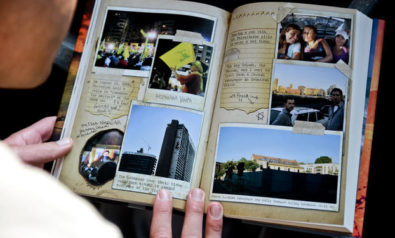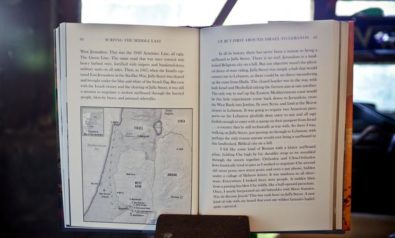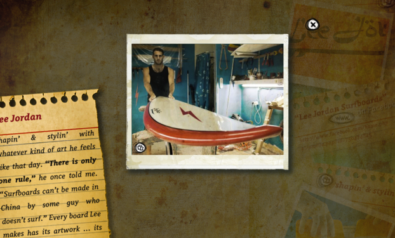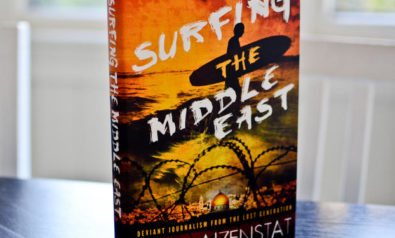The following is the first of a six-part series of excerpts that Fair Observer will be featuring from Jesse Aizenstat's Surfing the Middle East: Deviant Journalism from the Lost Generation.
Author's Note
Fresh off an El Al flight and a free Birthright trip, I arrive in Israel. With my surfboard Che, I take the coastal rail up to the northern city of Haifa. I encounter my first impressions of natural beauty, local surfers, and the combustible cocktail that runs throughout the book: surfing and conflict, and the mission to surf from Israel to Lebanon.
Surfing
In surfing, the waters run deep with unspoken customs. In California, there’s often this passive-aggressive thing out in the water, as surfers tend to give off a tough-guy stare and occasionally lay into each other with language. Sometimes they even trade blows. But it’s mostly cheap theater: a last-ditch jerk of the animalistic brain that masturbates to its own brutish power. So my plan was to do the Israeli surfing thing on a low-profile basis—at least till I could gain some kind of footing, gauge the temperature, know the ringmasters who whipped the beasts at the local circus. But it could easily backfire.
Though I had briefly seen people surfing Haifa in the summer of 2007, I didn’t surf there myself, so I really didn’t know much about these Israeli surfers. It was all so new to me that on this return trip, I wanted to hang out with the Haifa surfers and learn what I could about the place. I wanted a dose of local knowledge that could save me from getting stung by a jellyfish, hit by a stingray, or fired upon by some fiendish Islamist militia. And besides, most surfers in the world like to paddle out with friendlies to ride waves. It’s safer. More fun. But I had no idea whether these Haifa surfers would be willing to share their most prized asset with an unannounced dude from California. Would they ban me from their best spots? Would they run some kind of Israel Defense Forces kind of heckle on me? Perhaps they would see me as some soft American hebe, fresh off a Birthright Israel trip, leaving them no option but to make some kind of savage commando out of me. After all, I kept thinking, this was the Middle East. Just like the random kidnapping of Israeli soldiers that led to the outbreak of the 2006 war, anything could happen. At any time.
Some of those churning possibilities left me uneasy. Most of the time I felt great, on it, and in control. But there were moments when I wondered if my plan to surf the Middle East was simply too out there. My senses were not yet attuned to the world’s most combustible region. I couldn’t sniff out the difference between savage humor and approaching danger. I didn’t know how to assume things. Am I really prepared for the uncertainties of the Middle East? Have I wandered too far?
Ahh… careful! Careful! That psychological twister can freak out even the most brazen of travelers. And for me, it could have been just the thing that prevented me from getting to know the Haifa surfers. After a brief hesitation, I shook it off, thinking, Jesus, man, just go for it!
So it was a moment of luck (and utter amazement) that as soon as my taxi pulled up to the Port Inn in downtown Haifa, a total stranger came running up to me with a phone—right on cue. No sooner had I jammed Che through the sea-rusted door of the Haifa guesthouse than the inn manager handed me the phone with his “buddy who surfs” on the line. Was it really going to happen like this?
“Hello?” I mumbled into his old brick of a cellular.
“Hi. My name is Lee. I heard you are… a surfer?”
I’ll never forget Lee’s ecstatic voice over the crackly cell.
“You came on just the right day, man. The waves are building to head-high and the wind is… do you want to meet at Carmel Beach?”
Two hours later I was trading off waves in the salty break of the Mediterranean with Lee—a cool Israeli I knew absolutely nothing about. But sweet hell, what did it matter? He was a surfer.
It was under the second lifeguard tower at Carmel Beach—just a few easy stops down that coastal railway—that Lee and I slapped hands, chatted, and agreed effortlessly that the surf was worth riding. It was so natural. None of that awkwardness you might think would come from walking into a situation as strange as this one. This was surfing.
“Whoa!” Lee exclaimed. “I see you brought your own board.” He started inspecting the need-for-speed four-fin setup installed on Che’s bottom half. His eyes were glued to Che like a craftsman to his tools. He slowly slid his sturdy hand down the side rail of the board, inspecting the taper of Che’s feathered edge. Then he whipped him around, pausing to notice the notched swallowtail cut on the bottom of the board. Lee smiled with increasing approval. Then he flipped Che upside down, running his flat palm along the smooth bottom plane that would soon be polishing the warm sea-top.
“You know, I am a surfboard shaper,” said Lee with a calm modesty. “This shape is something I’ve never seen here in Israel… it’s perfect for our waves.”
I shrugged. I muttered something about how my friend Dave Johnson of Progressive Surfboards designed the foamy thing for what we thought would be the smaller, weaker waves of the Mediterranean. But I swallowed the “smaller and weaker” bit; the waves were breaking with solid A-frame peaks, with near head-high sets. Not exactly a session in Dinkertown, Flatville.
I started to grin. Lee already was.
“Well, Lee,” I burst out with excitement, “it’s time to test the damn thing.”
No nod required. The wild Israeli surf was waiting.
Read the second excerpt from Surfing the Middle East: Deviant Journalism from the Lost Generation on July 25.
The views expressed in this article are the author's own and do not necessarily reflect Fair Observer’s editorial policy.
Support Fair Observer
We rely on your support for our independence, diversity and quality.
For more than 10 years, Fair Observer has been free, fair and independent. No billionaire owns us, no advertisers control us. We are a reader-supported nonprofit. Unlike many other publications, we keep our content free for readers regardless of where they live or whether they can afford to pay. We have no paywalls and no ads.
In the post-truth era of fake news, echo chambers and filter bubbles, we publish a plurality of perspectives from around the world. Anyone can publish with us, but everyone goes through a rigorous editorial process. So, you get fact-checked, well-reasoned content instead of noise.
We publish 2,500+ voices from 90+ countries. We also conduct education and training programs
on subjects ranging from digital media and journalism to writing and critical thinking. This
doesn’t come cheap. Servers, editors, trainers and web developers cost
money.
Please consider supporting us on a regular basis as a recurring donor or a
sustaining member.
Will you support FO’s journalism?
We rely on your support for our independence, diversity and quality.











Comment